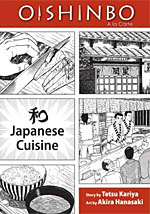 Written by Tetsu Kariya
Written by Tetsu Kariya
Art by Akira Hanasaki
272 pages, black and white
Published by Viz
I love that in Japan, it’s nothing out of the ordinary to have a comic centered around cooking. In the case of Tetsu Kariya and Akira Hanasaki’s Oishinbo, though, it’s all the more impressive when you consider that the comic has run since 1983, with over 100 collections to date in Japan. What to do to try and hook new readers who perhaps don’t have the time or attention span to plow through over 20,000 pages of manga? Enter the Oishinbo: A la Carte series, where each volume is a "best-of" compilation around a specific type of food. Now that Viz has translated the first volume, Oishinbo: A la Carte: Japanese Cuisine, I’m quite happy to say that creating that sort of collection was absolutely the way to go.
Yamaoka Shiro has been tasked by the Tozai News, as part of the newspaper’s 100th anniversary, to create an "Ultimate Menu" featuring the absolute best cuisine has to offer. Yamaoka thinks he has an edge because he learned much about food from his estranged father, renowned founder of the Gourmet Club and artist Kaibara Yuzan. As Yamaoka and his colleagues sample the food that Japan has to offer, though, Yamaoka will not only go head to head with his angry father, but with Yamaoka’s own headstrong belief that he knows everything about food. The reality, of course, is that everyone still has something to learn when it comes to the world of cooking.
The more I read of Oishinbo, the more I had my initial suspicions come true: the actual overarching plot of the book really doesn’t matter that much. Sure, there are wrinkles in the big plot that happen from time to time, like Kaibara accepting an offer from another newspaper to create a rival "Supreme Menu," or Yamaoka and his fellow reporter Kurita Yuko eventually falling in love and marrying. But you know what? That’s not what you read Oishinbo for, and the creation of the Oishinbo: A la Carte series in Japan more or less confirmed that. You read Oishinbo because of the information about food. This first volume has stories all about specific techniques and styles of cuisine from Japan; the art of sashimi, tea ceremonies, sushi knife skills, even the slightly obscure hospitality style known as gochiso. It’s a smart topic for this first book’s focus, because in many ways it really shows you what to expect. There’s a lot of knowledge imparted to the reader, as well as occasional actual recipes (which are included in full at the start of the book!) for different dishes. There were lots of things I’d never known about before, and as someone who loves to cook, Oishinbo: A la Carte has a strong attraction to me.
At the same time, each chapter does tell an actual story; sometimes Yamaoka’s knowledge saves the day, other times Yamaoka himself ends up learning a lesson the hard way. I was pleased that even though these chapters didn’t originally occur back-to-back, I never felt like I’d suddenly ended up left-behind by reading a "best-of" compilation. While there are footnotes in the back of the book that explain some of the developments since then (like the "Supreme Menu" being formed, or different characters getting married or pregnant), it’s never that important. Sure, it’s nice to get the extra pieces of information, but Oishinbo really isn’t about the characters at all, or even about finishing the "Ultimate Menu." After all, for a series that has run for over 25 years, you’d think by now that darn menu would otherwise have finally been complete. (Maybe they’re now aiming for the newspaper’s 125th anniversary?)
Hanasaki’s art in Oishinbo may come as a slight disappointment to seasoned comic readers. It’s a very average style, with slightly blocky heads for the male characters, and no particular pizzazz or flare for anything out of the ordinary. Oishinbo is very much a comic where the art is there to serve as a method of delivering the story, and nothing more. It never draws attention to itself, but it always competently tells the story and gets the ideas across. I’m not saying that Hanasaki’s art is bad, but I will admit that I was a little surprised at first at how utilitarian it was. That said, Hanasaki’s definitely good at drawing all of the food in Oishinbo, and considering that the script itself seems to exist to service the cooking knowledge of Kariya, that’s all that really matters.
Oishinbo: A la Carte: Japanese Cuisine was a fun read for me. I’ll admit that first I was a little wary about the idea of picking up multiple Oishinbo: A la Carte books over the fear that it would get old quickly. By the time I put Japanese Cuisine down, though, I was already wishing that I had the next volume in my hands. With upcoming volumes in 2009 including focuses on sake, ramen, gyoza, sushi, and vegetables, I’ve got a lot of reading ahead of me. With slightly larger dimensions than most manga, a nice heavy cover stock, and end flaps, Oishinbo has an attractive end product look as well. After all, in cooking, appearances do matter and Viz has taken no chances. If you like comics and like food, you should definitely take a look for yourself.
Purchase Links: Amazon.com
